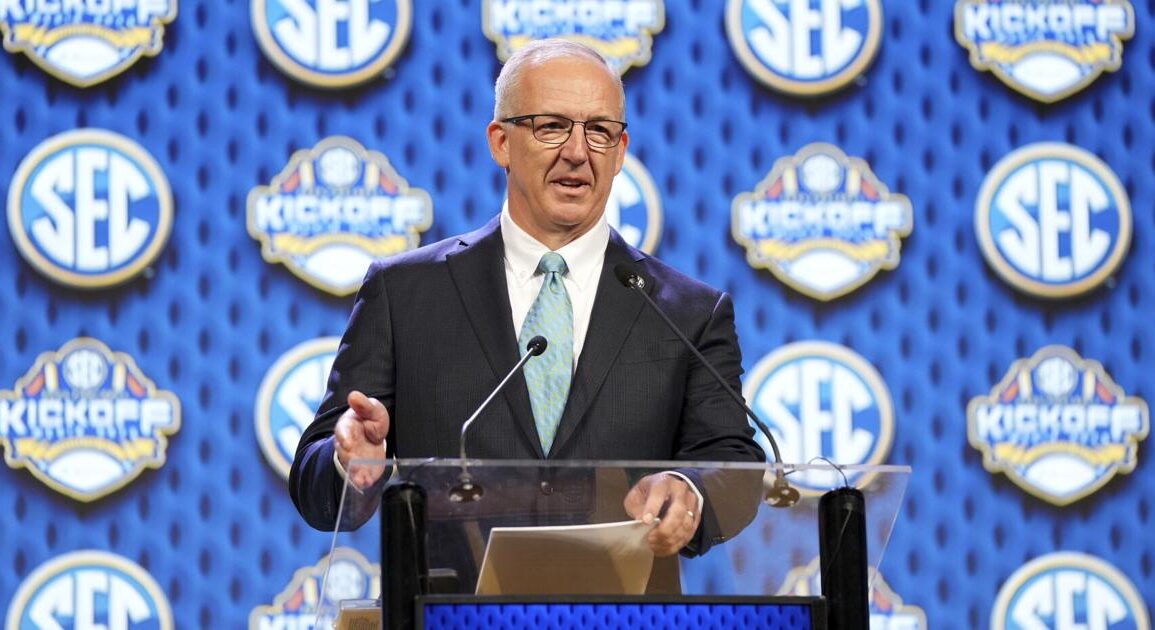
COLUMBIA — The biggest issue facing college football — the House settlement, which will usher in an era of schools paying their players — remains in waiting.
The SEC, leading the future of college football, is waiting while looking at the other items on the sport’s agenda.
“We’re kind of important,” Commissioner Greg Sankey said at the SEC spring meetings last week. “We’ve been important in that decision.”
The SEC is pushing for a revamping of the College Football Playoff, interested like other leagues in an increase to 16 teams instead of the 12 that debuted last season. The league also wants a change in the selection of those 16 after 2024 saw just three SEC teams selected with three others (Alabama, Ole Miss and South Carolina) denied despite boasting strong resumes.
The conference discussed a “5+11” model which would grant automatic playoff berths for the five highest-ranked conference champions and 11 at-large teams. It would largely eliminate the selection committee’s duties as they currently are and boast strength of schedule as the biggest factor.
In 2024, the top four seeds and first-round byes were reserved for conference champions. The new plan would match the committee’s final rankings with no affiliation to conference.
It’s one way that he thinks will solve the question of, “Are these truly the 12 (or 16) best teams?” It’s also a way to reward just how tough it is for any SEC team to make it through a conference schedule with just 1-2 losses.
The league distributed literature during the meetings to reporters about the SEC’s regular-season grind. The point is simple: Who you play, and how good they are, has to matter. Not as much as wins and losses, but the “1A” to the “1.”
The CFP format is the same for this year, but 2026 beckons as a time to expand and change the criteria for participation. The committee has until Dec. 1 to decide on a plan for 2026, which is delaying another SEC decision.
The conference usually releases schedules for the next year by summer of the previous year. The SEC can’t do that for 2026 until the CFP cements a format, because the discussion — should the SEC move to nine conference games, instead of eight? — remains ever-bubbling.
If there isn’t a solution at least by the end of summer, the SEC stands to keep the 2026 schedule at eight conference games in 2026. But a ninth, helped by a financial push from ESPN to televise another game, remains a lucrative straw to grasp.
“The pressure point for us is we’re going to have to make a decision for our 2026 schedule in a timeframe shorter than the deadline for CFP decisions,” Sankey said. “I’m not sure we can work through obligations in that.”
Other spring-meetings notables:
• LSU coach Brian Kelly said he’d like to play eight SEC games and one against a Big Ten team every season. That would drastically affect an SEC’s team strength of schedule, which would probably be good for CFP consideration, but also hurt a team like South Carolina.
The Gamecocks play ACC member Clemson every season, depriving them of having four game slots in which to pick and choose opponents (i.e., “cupcake games” that are nearly guaranteed wins). USC, like Georgia (Georgia Tech) and Kentucky (Louisville) has to make do with three pick-anyone opponents.
Cut that down to two because of playing Clemson, a Big Ten team and the SEC, it puts USC at a disadvantage. But Kelly’s idea doesn’t seem to have much traction.
• Sankey said that all 16 of the SEC’s schools have agreed to what the House settlement will dictate regarding how to govern NIL compensation. Even if individual states have already passed laws saying the NCAA can’t touch how their athletes are paid through outside agencies, the SEC’s schools will waive that right and abide by the House rules.
• The league has again reconstructed the fine system for fans on the field after games (storming the field or court). It’s $500,000 every time it happens now, with no more escalating fines.
• Sankey also said the league has reworked its basketball tiebreaking procedures after he had to flip a coin to determine who would be the No. 1 seed in the SEC women’s tournament last year (South Carolina won over Texas). Head-to-head point differential and NET ranking will determine the choice this year.
• Coaches would prefer just one transfer portal window, in the spring. It’s tough to have to deal with portal losses after the regular season and before bowl/CFP games.
• Elsewhere in conference spring meetings, NCAA President Charlie Baker confirmed they are discussing the expansion of the NCAA men’s basketball tournament. The tournament last expanded in 2011 when it added the two “play-in” games on the Tuesday before the rest of the tournament begins on Thursday.
Baker said that the idea of 72 or 76 teams — up from the current 68 — is on the table and, if approved, could happen this year.
This post was originally published on this site be sure to check out more of their content.










